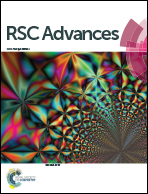Water-soluble gold nanoparticles based on imidazolium gemini amphiphiles incorporating piroxicam†
Abstract
Water soluble gold nanoparticles were synthesized in a single step using a double layer of a gemini imidazolium-based amphiphile as both reagent and stabilizer. The synthetic strategy exploits the amphiphilic nature of the ligand, and different ratios of ligand to Au(III) precursor were tested in order to favour the formation of amphiphile bilayer-coated nanoparticles, as indicated by their solubility and the thermogravimetric analysis, which proved the gold/organic ratio. The approximately 10 nm nanoparticles display cytotoxicity on Caco-2 cells similar to gold nanomaterials coated with other cationic surfactants, mainly because of their bilayer coating. Instead, genotoxicity was proven to be low, and the gold nanoparticles showed cell internalization being able to leave endosomes and without entering the nuclei. The incorporation of piroxicam, a poorly water soluble drug that has anti-inflammatory and antitumoral activity, was achieved thanks to anion binding by the amphiphile. Subsequently in vitro release of piroxicam from these nanoparticles was demonstrated, indicating their potential in combined chemotherapy.


 Please wait while we load your content...
Please wait while we load your content...